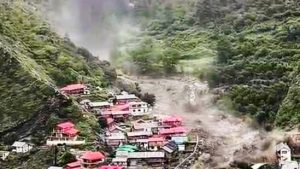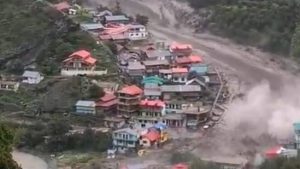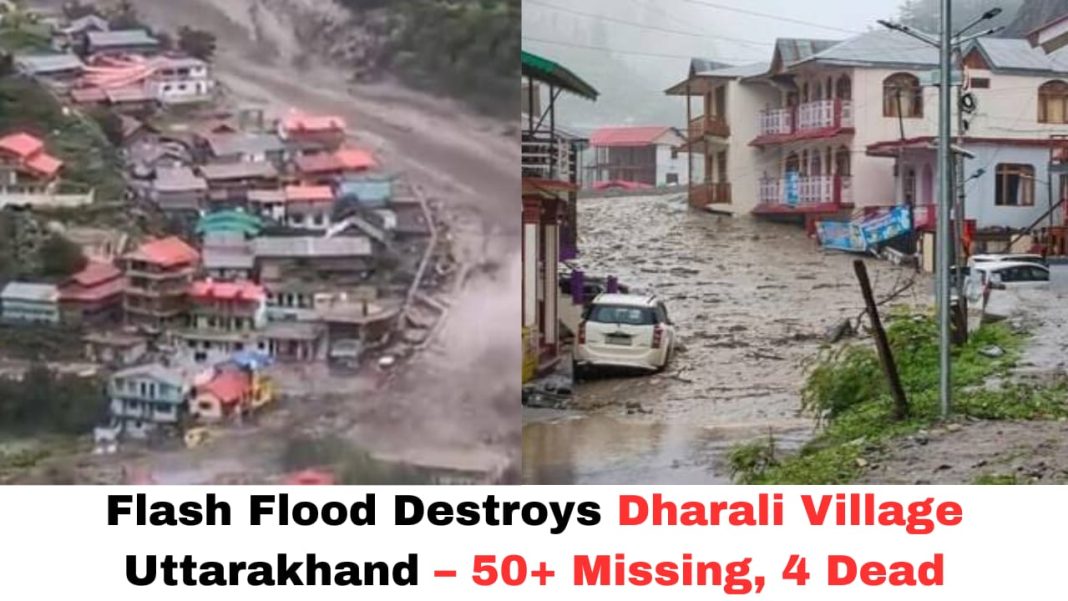Digital News Guru Uttarakhand Desk:
Catastrophe in the Hills: Cloudburst, Flood, and Debris Wipe Out Dharali Village
On August 5, 2025, a thunderous cloudburst struck the upper Kheer Ganga catchment area in the Harsil Valley of Uttarkashi district, Uttarakhand, triggering a deadly flash flood and massive mudslide that devastated Dharali village, a key stop en route to Gangotri Dham. The disaster, which unfolded in a matter of minutes, has become yet another painful chapter in Uttarakhand’s troubled history of monsoon-related catastrophes.
The Sudden Disaster
At approximately 1:45 PM local time, torrential rainfall—widely interpreted as a cloudburst—caused water levels in Kheer Ganga to rise abruptly. A wall of mud and debris surged into Dharali’s market, dragging away homes, roads, shops, and at least a dozen hotels and homestays in its wake.

Local eyewitnesses described scenes of utter destruction: “a massive debris slide encroaching into the town, taking with it structures,” and households disappearing under relentless water flow. Reports indicate 10–12 individuals may still remain buried beneath the wreckage.
Human Toll: Lives Lost and Many Missing
So far, four confirmed fatalities have been reported. The Uttarkashi district magistrate confirmed these deaths, while several dozen more are feared missing—some reports estimating over fifty individuals unaccounted for, including local residents and possibly tourists.
Authorities remain deeply concerned that many are trapped beneath collapsed buildings and debris, with rescue teams working through extremely treacherous terrain.
Rescue & Relief Operations in Full Throttle
In response to the crisis, multiple agencies have converged on the site. Teams from the Indian Army, State Disaster Response Force (SDRF), and National Disaster Response Force (NDRF), supported by local police and first responders, are actively engaged in search and rescue missions using sniffer dogs and heavy machinery.
The Indo-Tibetan Border Police (ITBP) has already rescued at least 50 people from the affected zones. Three helicopters have been requested to assist with aerial aid and evacuations, although the flood destroyed a local helipad, severely complicating air operations.
Several high-ranking government officials, including Union Home Minister Amit Shah and Chief Minister Pushkar Singh Dhami, have overseen the relief efforts, ordered deployment of additional teams, and expressed condolences. Operational control has been elevated with deployment of three IAS officers to Uttarkashi for coordination.
Environmental and Socioeconomic Impact
Beyond tragic loss of life, the flood has inflicted severe damage on local infrastructure, businesses, and livelihoods. More than twenty hotels and homestays, along with shops, restaurants, and roads, have been irreparably damaged or destroyed, severely disrupting local tourism—the primary economic lifeline of the region.
Agricultural and livestock losses are also mounting. In Banala Patti, Barkot tehsil, 18 goats were swept away in flash floods, underscoring the broad devastation across both communities and farming practices.

The Warning Signs Ignored: Uttarakhand’s Fragility
Experts and analysts highlight that Uttarakhand is no stranger to such fluid disasters. Triggered by similar causes—rapid snowmelt, extreme rain events, and unchecked hillside development—the state’s vulnerability has repeatedly surfaced in tragedies such as the 2013 Uttarakhand floods which killed over 6,000.
A confluence of factors contributes to this risk:
- Climate change intensifies cloudbursts and irregular precipitation in Himalayan regions.
- Unregulated tourism and construction: hotels built dangerously close to riverbanks, inadequate urban planning, and mass pilgrim traffic.
- The fragile geology of young mountains amplifies landslide risks.
Weather Outlook & Implications for Ongoing Operations
The India Meteorological Department (IMD) has issued a red rainfall alert across Uttarakhand until August 10, warning of continued monsoon surges and sudden cloudbursts in high-altitude zones. This heightens the risk of additional landslides and flash floods, jeopardizing both residents and rescue teams.
Communities are being urged to steer clear of swollen rivers like Bhagirathi, avoid low-lying areas, and heed official advisories. Schools in multiple districts, including Dehradun and Haridwar, have been shuttered as a precautionary measure.
Looking Forward: Recovery, Reform, Resilience
This tragedy underscores an urgent need for policy and planning reforms in Uttarakhand:
- Early warning systems and community awareness campaigns tailored to mountainous regions.
- Regulation of hillside construction and tourism infrastructure, especially near riverbanks and pilgrim routes.
- Long-term strategies: inclusive of climate adaptation, sustainable land use, and resilient disaster preparedness.
Despite official reassurances and ongoing relief plans, many locals fear another “Operation Surya Hope”‑style response pattern, which in the 2013 floods attracted criticism for delayed government action and insufficient preparedness.

Experts argue there must be a shift from emergency response to resilient infrastructure planning. Failure to heed earlier warnings, such as from 2013, leaves Uttarakhand vulnerable to recurring disasters. > “This event is part of a recurring pattern of ecological disasters… highlights the region’s vulnerability.”
Conclusion
The tragedy in Dharali village is yet another stark reminder of Uttarakhand’s fragile ecology and the mounting toll of monsoon disasters. With growing frequency due to climate change and escalating human-induced pressures on the hills, such catastrophes demand not just immediate relief—but systemic reform and long-term resilience planning.
As rescue efforts continue, prayers and concerns remain for the many still missing. The wider call is clear: Uttarakhand, with its scenic landscapes, must also build sustainable safeguards—before another storm claims more lives.
You May Also Read: Juhi Chawla Becomes India’s Richest Actress with Rs 4,600 Crore Net Worth








